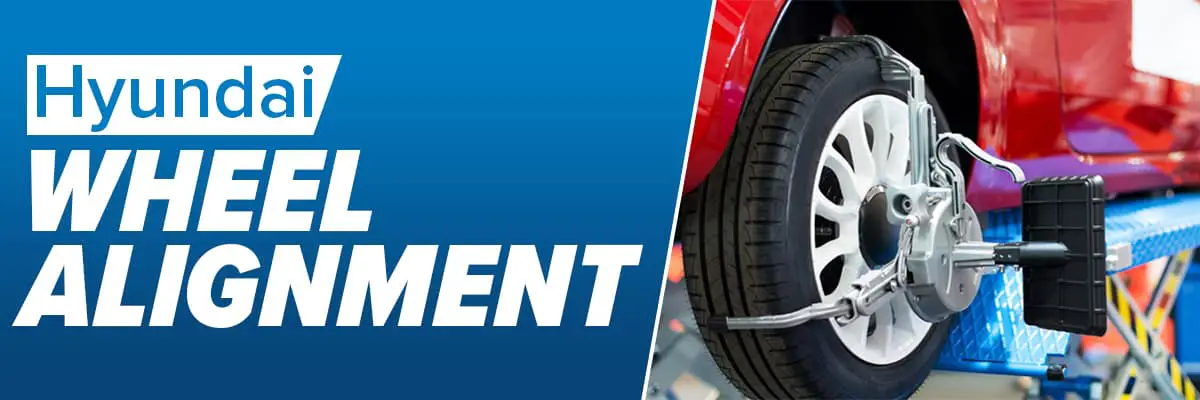Proper wheel alignment is vital for Hyundai vehicles. Regular alignment maintenance ensures that your car or SUV drives safely and smoothly. In this article, we will explore the essentials of Hyundai wheel alignment, including the signs of bad alignment, how to check it, and the associated costs. Understanding the importance of keeping your Hyundai’s wheels in proper alignment will not only extend the life of your tires but also enhance your driving experience. So, let’s delve into the world of Hyundai wheel alignment, answering your FAQs and helping you grasp why it matters for your vehicle’s performance and your wallet.
Understanding Wheel Alignment for Hyundai Vehicles

Wheel alignment is the precise adjustment of the angles at which your Hyundai’s wheels make contact with the road. It’s not just a technical procedure; it’s a critical aspect of vehicle maintenance that directly affects your safety, tire lifespan, and overall driving experience.
Importance of Hyundai Vehicles
Why is wheel alignment so essential for your Hyundai? Well, let’s start with tire lifespan. When your wheels are properly aligned, your tires wear evenly. This means your tires last longer, saving you money in the long run. But that’s not all. Proper alignment also enhances your vehicle’s performance. When your wheels are in sync with each other and the road, you’ll notice improved handling and maneuverability. Your Hyundai will drive straight without drifting, especially when you apply the brakes. And you won’t need to wrestle with the steering wheel to stay in your lane during highway journeys.
Key Alignment Terms
To understand wheel alignment fully, you should know some key terms.
- Camber refers to the angle at which the tire tilts inward or outward when viewed from the front. Correct camber ensures even tire wear.
- Caster involves the tilt of the steering components concerning the McPherson struts. It affects steering stability.
- Toe relates to the direction the tires point. Toe-in means they point slightly inward, and toe-out means they point slightly outward. Proper toe alignment prevents your Hyundai from drifting and ensures precise steering control.
Also Read: The 2024 BMW M2 Coupe: Performance, Features, Specs
Signs of Bad Alignment and Their Impact on Your Hyundai
-
Drifting
One of the most common signs of bad alignment is the sensation that your Hyundai tends to pull or drift to one side, especially when you’re driving on a straight road. This can be particularly noticeable when you take your hands off the steering wheel momentarily. Drifting occurs because the wheels are not properly aligned to point in the same direction.
-
Uneven Tire Wear
Bad alignment leads to uneven tire wear, meaning that your tires wear down at different rates. You might notice that one tire’s tread is wearing faster than the others. This not only shortens the lifespan of your tires but also has financial implications as you’ll need to replace them sooner than expected.
-
Steering Issues
If you find yourself constantly making small steering adjustments just to keep your Hyundai on a straight path, it’s a strong indicator of alignment problems. Bad alignment can cause a continuous “fight” between your steering and the road, making your driving experience less smooth and less safe.
Impact on Vehicle Safety and Performance
The signs mentioned above not only affect your wallet but also your safety and your Hyundai’s performance. When your car drifts, especially during braking, it can lead to instability and reduced control. This can be dangerous in critical situations.
Uneven tire wear due to bad alignment can also impact traction and handling, particularly in wet or slippery conditions. It reduces your vehicle’s ability to grip the road securely, increasing the risk of accidents.
Steering issues not only lead to a less comfortable drive but also contribute to driver fatigue. If you’re constantly battling the wheel to keep your car on course, it can lead to exhaustion and negatively impact your focus and reaction time.
Impact of Road Conditions on Alignment
It’s important to note that road conditions can accelerate the onset of bad alignment. Potholes, rough surfaces, and even minor collisions can knock your wheels out of alignment. So, if you regularly traverse poorly maintained roads or encounter rough surfaces, it’s especially crucial to keep a close eye on your Hyundai’s alignment.
Now that we’ve explored the common signs of bad alignment and their effects, you’ll be better equipped to recognize when your Hyundai needs alignment service. But if you’re wondering how you can check your car’s wheel alignment, we’ll delve into that in the next section.
How to Check Your Hyundai’s Wheel Alignment at Home

Checking your Hyundai’s wheel alignment at home is a straightforward process that can help you catch alignment issues early. Here’s a step-by-step guide to help you:
Step 1: Find a Suitable Location
Park your Hyundai on a level, flat surface. Make sure the car is on stable ground.
Step 2: Check Tire Pressure
Before inspecting alignment, ensure that your tires are properly inflated. Inconsistent tire pressure can mimic alignment issues.
Step 3: Visual Inspection
Stand in front of your car and look at your front tires. Ensure they are pointing straight ahead. If they appear to tilt outward or inward significantly, it could indicate alignment problems.
Step 4: Rear Tire Inspection
Move to the back of your car and examine the rear tires in the same way. They should also point straight ahead.
Step 5: Use a String Method
If you want to be more precise, you can use the string method. Stretch a string from the front tires to the rear tires on each side. The string should just graze the surface of the tire. This helps you check if the tires are aligned correctly. Any significant deviation indicates an alignment issue.
The Importance of Regularly Inspecting Alignment
Regularly inspecting your Hyundai’s wheel alignment is crucial for several reasons. First and foremost, it helps you identify alignment problems early, preventing them from escalating into more significant and costly issues. Addressing alignment problems promptly can save you money on tire replacement and other related repairs.
Furthermore, a well-aligned car is a safe car. It ensures that your vehicle responds predictably when you steer or brake, enhancing your control and safety while driving.
Common Tools and Methods for Checking Alignment

While the steps mentioned above provide a basic way to check your Hyundai’s alignment at home, professional alignment services are more precise and thorough. Most modern cars, including Hyundai vehicles, have complex suspension systems and require specialized equipment to ensure accurate alignment.
Professional alignment services typically use laser-guided or computerized alignment equipment, which offers precise measurements and adjustments. It’s advisable to have your Hyundai’s alignment checked by a qualified technician, especially if you notice any signs of bad alignment. These professionals can quickly and accurately diagnose and rectify any issues, ensuring your car remains safe and efficient on the road.
Hyundai Wheel Alignment Cost
The cost of wheel alignment for your Hyundai can vary based on several factors, including the type of alignment required (2-wheel or 4-wheel) and your geographic location. While specific costs may fluctuate, here are some general estimates to give you an idea of what to expect:
- 2-Wheel Alignment
Typically, a 2-wheel alignment, also known as a front-end alignment, is more budget-friendly. On average, you can expect to pay anywhere from $50 to $75 for this service, depending on where you live and the specific service center.
- 4-Wheel Alignment
A 4-wheel alignment, which is more comprehensive and ensures all four wheels are aligned correctly, tends to be a bit pricier. You might find the cost ranging from $100 to $150 or more.
Please note that these figures are approximate and can fluctuate significantly based on your location, the service center’s pricing, and any additional adjustments or repairs needed. It’s advisable to get a precise quote from a trusted Hyundai service provider.
Why Proper Alignment Can Save You Money
While it’s understandable to consider the cost of wheel alignment, it’s important to recognize that proper alignment can actually save you money in the long run. Here’s how:
- Extended Tire Lifespan
When your wheels are properly aligned, your tires wear evenly. This means your tires last longer, and you won’t need to replace them as frequently. This can potentially save you hundreds of dollars over time.
- Fuel Efficiency
Proper alignment can also lead to improved fuel efficiency. When your tires are aligned correctly, your Hyundai doesn’t have to work as hard to move forward, resulting in better gas mileage. This means fewer trips to the gas station and more money in your pocket.
- Reduced Repairs
Correct alignment can prevent premature wear and tear on your suspension and steering components. By avoiding the additional costs associated with these repairs, you can keep your maintenance expenses in check.
- Safer Driving
Proper alignment ensures your Hyundai handles predictably, reducing the risk of accidents. Fewer accidents mean fewer expenses related to car repairs and insurance claims.
FAQs About Hyundai Wheel Alignment
How often does a Hyundai need alignment?
Typically, it’s recommended to have your Hyundai’s alignment checked annually. However, the frequency can vary based on factors like your driving habits and road conditions. It’s a good practice to check alignment every 6,000 to 10,000 miles.
What is the difference between wheel alignment and wheel balancing?
Wheel alignment focuses on adjusting the angles at which your wheels make contact with the road, ensuring they’re parallel and perpendicular. Wheel balancing, on the other hand, evens out the weight distribution of your tires and wheels, preventing vibrations and uneven tire wear.
When should you seek professional alignment services?
It’s advisable to seek professional alignment services if you notice any signs of bad alignment, such as drifting, uneven tire wear, or steering issues. Additionally, after hitting potholes or rough surfaces, or when installing new tires, professional alignment services can help ensure your Hyundai’s safety and performance.
Can I check the alignment at home?
Yes, you can perform a basic visual alignment check at home. However, for precise measurements and adjustments, it’s recommended to have your Hyundai’s alignment checked by a qualified technician using specialized equipment.
How does bad alignment affect tire lifespan?
Bad alignment causes uneven tire wear, shortening the lifespan of your tires. Tires may need replacement sooner, which can be more costly than regular alignment maintenance.
Is wheel alignment necessary for all Hyundai models?
Yes, wheel alignment is essential for all Hyundai models. Proper alignment ensures your vehicle drives safely, with better handling and reduced tire wear, regardless of the specific Hyundai model you own.
Can proper alignment save money in the long run?
Yes, maintaining proper alignment can save you money in various ways, including extending tire lifespan, improving fuel efficiency, reducing repair costs, and enhancing safety, all of which contribute to long-term financial savings.
Conclusion
Hyundai wheel alignment is a crucial aspect of vehicle maintenance. Regular checks and professional services are essential for safety and savings. By addressing alignment issues promptly and maintaining proper alignment, you not only ensure a smoother, safer ride but also extend the lifespan of your tires, enhance fuel efficiency, and reduce the risk of costly repairs.




